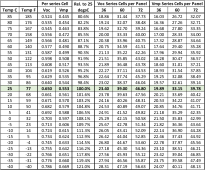featherlite
Solar Enthusiast
I currently have six 100 watt 12v Renogy Mono panels with the specs below: note 36 cells per panel.
I am looking at buying some 12v Rich Mono panels with the specs below: note 33 cells per panel.
I currently use a pair of Bogart PWM charge controllers.
I want to add more panels and upgrade to a Victron MPPT system and also want the flexibility of connecting the panels in various series-parallel configurations.
The Rich panels are the only panels I can find that match the existing Renogy volts and AH, and my physical size requirements. Moreover, the Rich panels are the only panels I have found that have 12 AWG wires rather than 14 AWG wires. My old Renogy panels have 10 AWG wires.
Question: Will the 33 cell Rich panels pose a problem?
PS: I still do not know if the Rich panels have any diodes. My research is ongoing.
Thank you for any input you can provide!

I am looking at buying some 12v Rich Mono panels with the specs below: note 33 cells per panel.
I currently use a pair of Bogart PWM charge controllers.
I want to add more panels and upgrade to a Victron MPPT system and also want the flexibility of connecting the panels in various series-parallel configurations.
The Rich panels are the only panels I can find that match the existing Renogy volts and AH, and my physical size requirements. Moreover, the Rich panels are the only panels I have found that have 12 AWG wires rather than 14 AWG wires. My old Renogy panels have 10 AWG wires.
Question: Will the 33 cell Rich panels pose a problem?
PS: I still do not know if the Rich panels have any diodes. My research is ongoing.
Thank you for any input you can provide!

Last edited:



